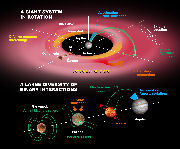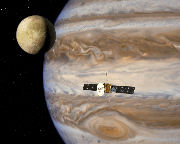








|
JUICE
The JUpiter ICy moons Explorer
(JUICE) will perform detailed investigations of Jupiter and its system
in all their inter-relations and complexity with particular emphasis on
Ganymede as a planetary body and potential habitat. Investigations of
Europa and Callisto would complete a comparative picture of the
Galilean moons.
The focus of
JUICE is to
characterise the conditions that may have led to the emergence of
habitable environments among the Jovian icy satellites, with special
emphasis on the three ocean-bearing worlds, Ganymede, Europa, and
Callisto. Ganymede is identified for detailed investigation since it
provides a natural laboratory for analysis of the nature, evolution and
potential habitability of icy worlds in general, but also because of
the role it plays within the system of Galilean satellites, and its
unique magnetic and plasma interactions with the surrounding Jovian
environment. Electrodynamic interactions play a variety of roles in the
Jovian system: generation of plasma at the Io torus, magnetosphere /
satellite interactions, dynamics of a giant plasma disc coupled to
Jupiter's rotation by the auroral current system, generation of
Jupiter's intense radiation belts.
JUICE will carry 11 experiments developed by scientific
teams from 15 European countries, the United States and Japan.
The solar-powered spacecraft will carry cameras and
spectrometers, a
laser altimeter and an ice-penetrating radar instrument. The mission
also will carry a magnetometer, plasma and particle monitors, and radio
science hardware. Planned for launch in 2022 and arrival at Jupiter in
2030. It will spend at least three years making detailed observations
of the giant gaseous planet Jupiter and three of its largest moons,
Ganymede, Callisto and Europa.
A remote
sensing package includes
imaging (JANUS) and spectral-imaging capabilities from the ultraviolet
to the sub-millimetre wavelengths (MAJIS, UVS, SWI). A geophysical
package consists of a laser altimeter (GALA) and a radar sounder
(RIME) for exploring the surface and subsurface of the moons, and a
radio science experiment (3GM) to probe the atmospheres of Jupiter and
its satellites and to perform measurements of the gravity fields. An in
situ package comprises a powerful package to study the particle
environment (PEP), a magnetometer (J-MAG) and a radio and plasma wave
instrument (RPWI), including electric fields sensors and a Langmuir
probe. An experiment (PRIDE) using ground-based very-long-baseline
interferometry will provide precise determination of the spacecraft
position and velocity.
The SGF Co. Ltd. together with Wigner RCP are
participating in the
development
of the PEP instrument lead by Swedish Institute of Space
Physics (IRF) Kiruna and in the development of the
J-MAG instruments lead by Imperial College London. The
SGF Co. Ltd. is developing the Electrical Ground Support Equipment
for
both PEP and J-MAG instruments.
26.
December
2014
|

Electrodynamic
Interactions at the Jovian system

JUICE
spaceprobe at Jupiter
(Artist
impression)
|


